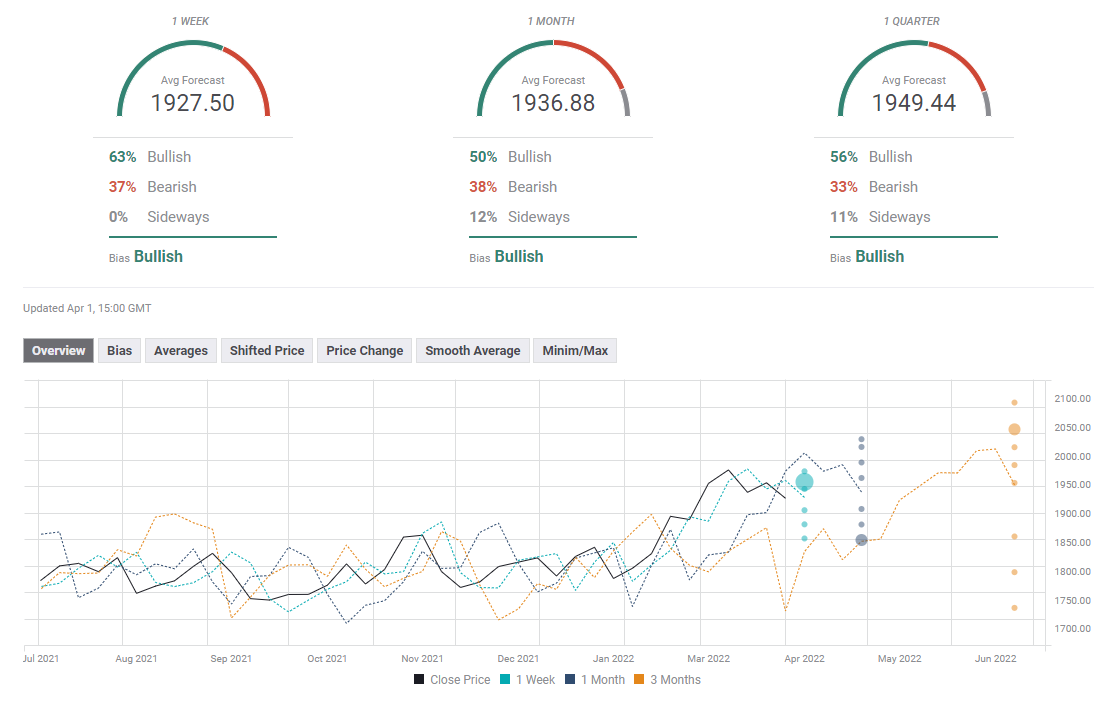- Gold recovered from monthly lows but closed the week in the red.
- The technical outlook points to a neutral bias in the near term.
- FOMC Minutes next week could impact the market pricing of Fed rate hikes.
Gold suffered heavy losses at the beginning of the week amid surging US Treasury bond yields but managed to stage a rebound mid-week. With the greenback starting to gather strength ahead of the weekend, XAU/USD failed to extend its recovery and ended up posting weekly losses.
What happened last week?
The bond selloff continued on Monday and the yield on the benchmark 10-year reference reached its highest level since May 2019 at 2.55%, causing inversely-correlated gold to fall sharply. XAU/USD extended its slide and touched its weakest level in nearly a month at $1,873 early Tuesday.
With month/quarter-end flows triggering a decline in yields on Wednesday and Thursday, XAU/USD reversed its direction and gained nearly 1% in that two-day period. Some cautious comments from Fed officials on the policy outlook also weighed on yields in the first half of the week.
"There are some signs in the data, and in what we hear from our contacts, that supply chain constraints are finally easing,” Philadelphia Fed President Patrick Harker said and argued that rate hikes need to be deliberate and methodical. Additionally, Atlanta Fed President Raphael Bostic noted that the heightened uncertainty due to the Russia-Ukraine conflict was a source of risk for demand.
In the meantime, risk flows dominated the markets amid renewed optimism for a diplomatic solution to the Russia-Ukraine conflict and caused the safe-haven dollar to lose interest. Following Tuesday’s talks, a Ukrainian negotiator said that they made enough progress to plan a meeting between Ukrainian President Volodymyr Zelenskyy and his Russian counterpart Vladimir Putin. Furthermore, Russia’s ministry of defense announced that military activity in Kyiv and Chernihiv will be scaled down significantly in order to create conditions for further dialogue.
On Wednesday, the data from the US showed that employment in the private sector increased by 455,000 in March and the real Gross Domestic Product expanded at an annualized rate of 6.9% in the fourth quarter. The US Bureau of Economic Analysis reported on Thursday that the Core Personal Consumption Expenditures (PCE) Price Index, the Fed’s preferred gauge of inflation, edged higher to 5.4% on a yearly basis from 5.2% Although this print came in slightly lower than the market expectation of 5.5%, it helped the dollar hold its ground and limited XAU/USD’s upside.
The 10-year US T-bond yield regained its traction on Friday and retraced the majority of its weekly decline, making it difficult for gold to build on its recovery gains. The US Bureau of Labor Statistics announced that Nonfarm Payrolls in March rose by 431,000, compared to analysts' estimate of 490,000. More importantly, the underlying details of the jobs report revealed that wage inflation, as measured by Average Hourly Earnings, climbed to 5.6% on a yearly basis from 5.2%. US T-bond yields continued to stretch higher after these figures, not allowing XAU/USD to turn north.
Next week
The ISM Services PMI data will be featured in the US economic docket on Tuesday. FOMC policymakers have been paying close attention to inflation data since the beginning of the year. Hence, investors are likely to react to the Prices Paid component, which is expected to rise to 83.3 in March from 83.1 in February, rather than the headline PMI reading.
On Wednesday, the FOMC will publish the minutes of the March policy meeting. As it currently stands, the CME Group FedWatch Tool shows that markets are pricing in a 71% probability of a 50 basis points rate hike in May. In case the publication reveals that policymakers are willing to continue to raise the policy rate in an aggressive way in the upcoming meetings, US Treasury bond yields could continue to push higher and weigh on gold.
Market participants will also watch the developments surrounding the Russia-Ukraine conflict. Russia is reportedly moving its troops around and preparing for another offensive rather than pulling away. Furthermore, Russia announced late Thursday that they will force gas purchases to be made in roubles. If the west ramps up sanctions and tensions re-escalate with Russia turning aggressive against Ukraine, investors could start seeking refuge in gold. The precious metal should find demand in a risk-averse atmosphere, although the dollar’s valuation is likely to be the primary driver of XAU/USD’s price action.
Gold technical outlook
Gold continues to fluctuate between the 20-day and 50-day SMAs. The Relative Strength Index (RSI) indicator on the daily chart is also moving sideways near 50, reflecting XAU/USD indecisiveness.
The Fibonacci 50% retracement of the latest uptrend forms the first support at $1,920. With a daily close below that level, additional losses toward $1,900 (psychological level, 50-day SMA) and $1,890 (Fibonacci 61.8% retracement) could be witnessed.
On the upside, gold needs to rise above $1,950 (Fibonacci 38.2% retracement, 20-day SMA) and start using that level as support in order to target $1,970 (static level) and $1,990 (Fibonacci 23.6% retracement).
Gold sentiment poll
The majority of experts that took part in the FXStreet Forecast Poll see gold edging higher in the near term. The one-month outlook paints a mixed picture and the average price target of $1,936 highlights the lack of a clear directional clue.
Information on these pages contains forward-looking statements that involve risks and uncertainties. Markets and instruments profiled on this page are for informational purposes only and should not in any way come across as a recommendation to buy or sell in these assets. You should do your own thorough research before making any investment decisions. FXStreet does not in any way guarantee that this information is free from mistakes, errors, or material misstatements. It also does not guarantee that this information is of a timely nature. Investing in Open Markets involves a great deal of risk, including the loss of all or a portion of your investment, as well as emotional distress. All risks, losses and costs associated with investing, including total loss of principal, are your responsibility. The views and opinions expressed in this article are those of the authors and do not necessarily reflect the official policy or position of FXStreet nor its advertisers. The author will not be held responsible for information that is found at the end of links posted on this page.
If not otherwise explicitly mentioned in the body of the article, at the time of writing, the author has no position in any stock mentioned in this article and no business relationship with any company mentioned. The author has not received compensation for writing this article, other than from FXStreet.
FXStreet and the author do not provide personalized recommendations. The author makes no representations as to the accuracy, completeness, or suitability of this information. FXStreet and the author will not be liable for any errors, omissions or any losses, injuries or damages arising from this information and its display or use. Errors and omissions excepted.
The author and FXStreet are not registered investment advisors and nothing in this article is intended to be investment advice.
Recommended Content
Editors’ Picks

EUR/USD maintains its constructive tone near 1.1400
EUR/USD remains well bid in the proximity of the 1.1400 hurdle on Thursday, deriving support from the renewed selling pressure in the US Dollar as investors continue to assess the ongoing absence of further progress in the US-China trade conflict.

GBP/USD appears sidelined around 1.3300, USD remains offered
GBP/USD holds its ground near the 1.3300 mark on Thursday amid a strong rebound in the broader risk-linked universe, all against tha backdrop of renewed weakness around the Greenback and steady uncertainty over US–China trade relations.

Gold eases from tops, back near $3,300
Gold manages to regain composure and reverses two daily drops in a row, currently approaching the $3,300 mark per troy ounce following the earlier bull run to the boundaries of $3,370. Furthermore, XAU/USD attracted safe-haven flows amid renewed concerns of a US-China trade flare-up.

Bitcoin Price corrects as increased profit-taking offsets positive market sentiment
Bitcoin (BTC) is facing a slight correction, trading around $92,000 at the time of writing on Thursday after rallying 8.55% so far this week. Institutional demand remained strong as US spot Exchange Traded Funds (ETFs) recorded an inflow of $916.91 million on Wednesday.

Five fundamentals for the week: Traders confront the trade war, important surveys, key Fed speech Premium
Will the US strike a trade deal with Japan? That would be positive progress. However, recent developments are not that positive, and there's only one certainty: headlines will dominate markets. Fresh US economic data is also of interest.

The Best brokers to trade EUR/USD
SPONSORED Discover the top brokers for trading EUR/USD in 2025. Our list features brokers with competitive spreads, fast execution, and powerful platforms. Whether you're a beginner or an expert, find the right partner to navigate the dynamic Forex market.


